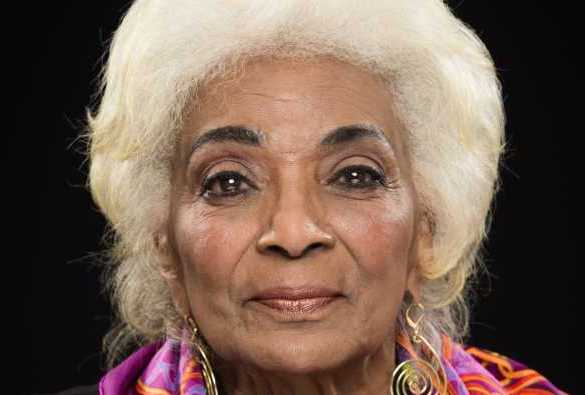She changed the future by simply believing in it. Nichelle Nichols in “WOMAN IN MOTION,” the Todd Thompson documentary on a one-woman drive to bring NASA into the 21st century
“We’re not just fancy little things. We are human beings and we come in all forms.”
From the world of jazz and dance to an historical television series to leading the effort to get more people of color in the space program, actress Nichelle Nichols has had a full life on and off screen. It is a life of dotted with history-making accomplishments though one that, frankly, I was not familiar with beyond Nichelle’s work in “Star Trek.”
Director Todd Thompson’s “Woman in Motion” is the story of Nichelle Nichols’s life journey. From science fiction to science fact, what a journey it was!
Most everyone knows of Nichelle Nichols and her character Lt. Uhura on “Star Trek.” Nichols named her own character. The book Uhhru about the Mau Mau Uprising in Africa meant a lot to the actress, so she championed to name her own character. Changing the end “u” to an “a “she became Uhura and fought for her character to be stronger. Frustrated with her perfunctory technical dialogue, the actress fought for more to do and say. She told Gene Rodennberry, “She’s the Chief Communications Officer and she can’t talk? What good is she?” If the character was to be only set dressing spouting technical lines that don’t get her involved in the story, Nichols was ready to call it quits.
Martin Luther King Jr. met her and informed her that “Star Trek” was the only show he let his children watch. Nichols told King that she was getting ready to quit the show in frustration. King told her she should stay.
In a moving memory, the actress recalls what Dr. King said to make her stay. King told her, “You don’t understand the effect you are having… not only on black people, not only on women… but on everybody. An attitude is changed immeasurably simply because you are there.”
The actress became aware that her character helped black viewers see that they were going to be present in whatever future was to come. The actress and character were making a powerful statement of which Nichols was not even aware until her eyes were opened to her role in history.
It was at a Star Trek convention in the mid-seventies where Nichols met Dr. Jesco Von Puttkamer, NASA’s Director of Science.
Nichols was in awe of Puttkamer’s presentation, yet she realized that she didn’t see herself represented in the space program. Not as woman, not as a person of color, either.
In 1977 Nichols was appointed to the board of directors of the National Space Institute. Giving a speech, Nichols asked simply, “Space. What’s in it for me. Where are my people?” She meant it then, and she means it now.
This was the spark that led to NASA opening up to recruiting women and people of color. To Nichols’s delight and surprise, they were listening.
Women in Motion is the name of Nichelle Nichols’s historic company of her own creation, founded to recruit potential minority-based candidates for the space program that was the driving force behind the diversity of the space program.
The actress walked it liked she talked it, putting her acting career on hold to focus on her work with NASA, going so far as to take the astronaut training so she could be more knowledgeable in what recruits would go through.
Nichols’s story is the story of so many, and her groundbreaking work on television and with NASA is felt throughout the stories of the people whose lives and careers were enriched by her work.
In their own words we hear how Nichols’s drive for diversity gave many black men and women the courage to become astronauts, with one career astronaut commenting, “I know she is speaking to me directly.”
A powerful and heartbreaking moment comes when Nichols reflects on the fateful day in January 1986 when the Space Shuttle Challenger exploded on liftoff seventy-three seconds into its flight, killing all seven crew members aboard.
Nichols is unable to continue the scene. She’s overwhelmed with emotion. Of the seven crew members, Nichols knew them all but had a close friendship with astronaut Judith Resnick particularly. “It was like this was happening to our family.” Three of Nichols’s recruits died in the tragedy that day.
It is the Challenger tragedy that symbolizes this film’s dual themes of optimism and perseverance in overcoming the odds and moving forward with change. Being part of that change is Nichelle Nicholss greatest accomplishment.
Director Thompson uses interviews, recent and old, and archival footage to bring home the historical significance of Nichols’s efforts in moving NASA into the 21st century. Thompson doesn’t use gimmicks, he knows he needs only Nichelle Nichols and the stories of the men and women whose lives and careers were strengthened by her tireless work. The power is in the person.
The actress/activist got in the door that allowed her the opportunity to move history forward because she played Lt. Uhura. They listened to her because she was Nichelle Nichols.
She changed the future by simply believing in it.
In watching this wonderful and eye-opening documentary, I was moved—deeply. To quote Nichols, “It made me believe that all good things are possible.”
“Woman in Motion” is a marvelous documentary about a woman using her power for change. Nichelle Nichols profoundly changed the world. This excellent experience will change the way you see her.
And stay for the end credits. You will be rewarded.
news via inbox
Nulla turp dis cursus. Integer liberos euismod pretium faucibua





